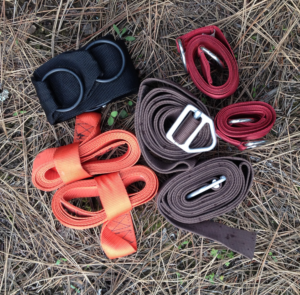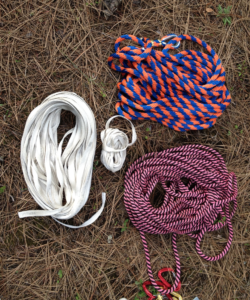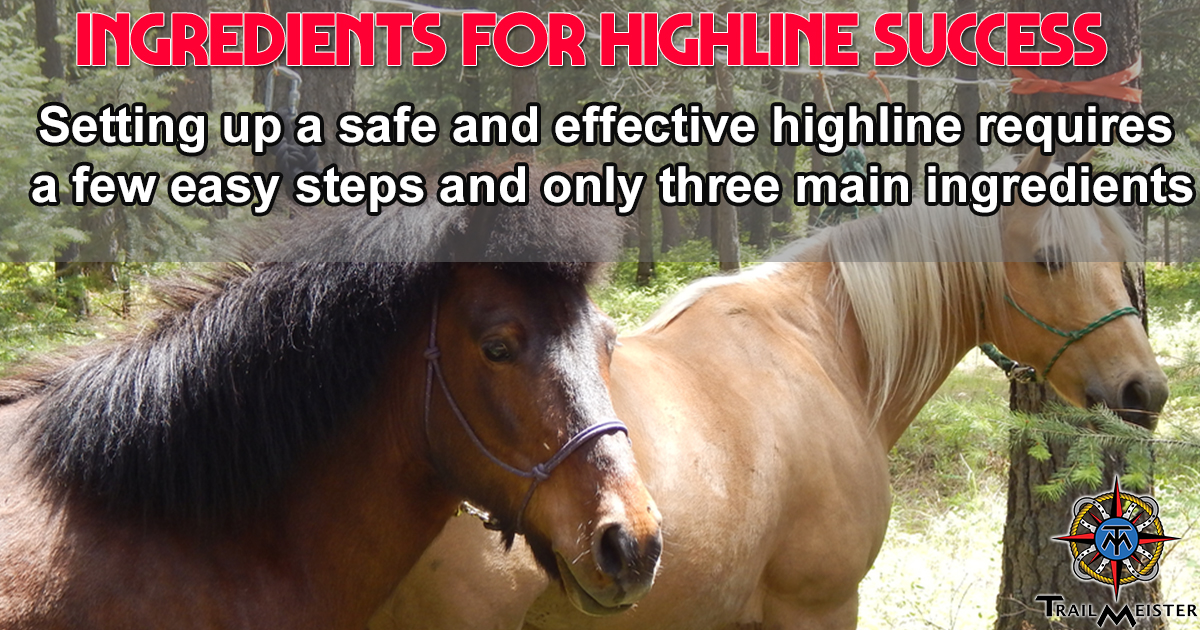If you’re an experienced horse camper, or want to be an experienced horse camper, you’ve most likely either used or have heard of the “high line”. Done well a highline is an exceptionally useful low-impact method for keeping our furry four legged toddlers out of mischief. Done poorly there are few things that give the equestrian community a worse reputation.
Just as cooking a great campfire meal requires following a few simple steps, setting up a safe and effective highline requires a few easy steps and only three main ingredients that you may already have.
Highline Ingredient List:
- 2 Stout objects – At its simplest a highline is just a rope tied between two stable objects such as trees or even horse trailers. Since horse trailers and pre-built facilities are lacking in most back country scenarios, look for trees that are live, sturdy, and at least 8 – 10 inches in diameter. Look up and check for dead branches that could fall. Failure to select the right supports for your highline will be a self-correcting problem that you won’t soon repeat.
 1 Pair Tree Saver Straps – As their name implies these 2 to 3-inch wide webbing straps protect trees by minimizing girdling and damage to the bark and cambium layer of trees. Use of tree savers is the law in many areas and highly encouraged everywhere else. Using tree savers helps to ensure that equestrian use will continue to be permitted in years to come. Many style are available. Some have rings built in and some even include adjustable buckles. I prefer tree savers that are brightly colored so that they are less apt to be misplaced and forgotten. Discarded cinches or car seat belts are good alternatives for the penny pinchers among us.
1 Pair Tree Saver Straps – As their name implies these 2 to 3-inch wide webbing straps protect trees by minimizing girdling and damage to the bark and cambium layer of trees. Use of tree savers is the law in many areas and highly encouraged everywhere else. Using tree savers helps to ensure that equestrian use will continue to be permitted in years to come. Many style are available. Some have rings built in and some even include adjustable buckles. I prefer tree savers that are brightly colored so that they are less apt to be misplaced and forgotten. Discarded cinches or car seat belts are good alternatives for the penny pinchers among us.
 Rope – This is the component that your animals will be tied to so you want a material that won’t break or stretch when pulled on by several 1,000+ pound animals. “Skookum” (from the Salish word for big – strong – mighty) is a good thing to look for in a highline rope. Make sure that it’s Skookum strong.
Rope – This is the component that your animals will be tied to so you want a material that won’t break or stretch when pulled on by several 1,000+ pound animals. “Skookum” (from the Salish word for big – strong – mighty) is a good thing to look for in a highline rope. Make sure that it’s Skookum strong.
- How long should a highline rope be? I’m a believer in “more is better”. It’s better to have rope not used than wishing for “just a few more feet”. I generally carry 50 – 100 foot lengths. My favorite highline rope material is polypropylene because it has less stretch than nylon, doesn’t absorb water, and feels good in hand. A 3/8 inch, 3 strand, poly rope is plenty strong (over 2,400 pound breaking strength) and more resistant to abrasion than other materials. Pretty much any modern good-quality rope, properly treated against UV damage, is extraordinarily resilient and will last for many years.
- Knowledge –
- Five basic workhorse knots everyone should know
- Half-hitches—Used to secure a your highline . Learn How.
- Bowline— The King of Knots. Easy to tie and untie. Learn How.
- Alpine Loop – To create a fixed in line loop. Excellent as part of the truckers hitch set up. Learn How.
- Trucker’s hitch—great for tensioning guy lines or for rigging a continuous ridge line. The 3-to-1 mechanical advantage lets you more easily get a highline tight. Here’s a groovy video!
- Prusik knot—Created for use in climbing, the prusik is a simple friction knot with a lot of uses, especially for a sliding adjustments. Learn How. Watch the video.
Ingredient Variations:
- Carabiners – These lightweight, metal snap-links can be used for a wide variety of tasks. While not a necessity, including a few carabiners into your highline recipe adds a lot of versatility by providing quick attachment points, improved adjustability, reduced friction and increased mechanical advantage. If you choose to use carabiners be sure to use climbing certified devices NOT the cheap links sold at the hardware store.
- Knot eliminators and rope winches – For the knot averse these gadgets are expensive, heavy, and often redundant “solutions” that sometimes create more unwanted hassles. Use them at your own peril.


